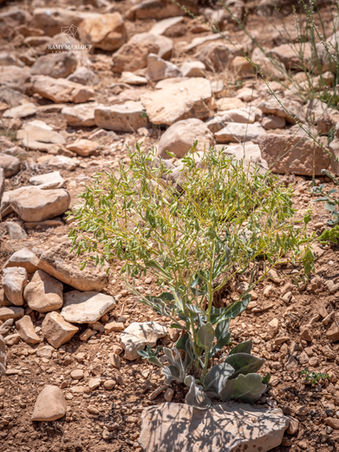Family |
Brassicaceae
Isatis cappadocica subsp. macrocarpa
(Jaub. & Spach) P.H.Davis
Isatis cappadocica subsp. macrocarpa (Jaub. & Spach) P.H.Davis
(Flora of Turkey 1: 290–294, 1965; Nouvelle Flore du Liban et de la Syrie, vol. 2, p. 107; Pl. XLI nº 1; 1966)
• Life-form & habit: Perennial, sometimes suffrutescent, 20–70 cm tall. Stems slender, pubescent or glabrous, often glaucous.
• Leaves: Basal leaves oblanceolate to obovate, entire or slightly dentate. Cauline leaves oblong to linear-oblong, the upper narrower, obtusely to distinctly auriculate.
• Inflorescence & flowers: Corymbose, branches elongated, flowers numerous, yellow. Calyx spreading, yellowish. Petals 4–5 mm, bright yellow.
• Fruit: Silicules very variable in shape among subspecies. In subsp. macrocarpa large, suborbicular to ovate or ovate-elliptic, up to 30 mm long; margin flat. In contrast, subsp. cappadocica has much smaller silicules (c. 10 mm), while subsp. subradiata has obovate to broadly elliptic fruits, about twice as long as wide (e.g., 15 × 7 mm in Djebel Druze).
• Phenology: Flowers May–June.
• Habitat & elevation: Rocky slopes and open habitats.
• Lebanese distribution: Collected by Boissier at Les Cèdres (now extinct locally according to Mouterde).
• Syrian distribution: Anti-Lebanon (Manchoura, Bloudane), Djebel Druze (Herbette), Bosra–Salkhad, Sahouet-el-Khodor, Harissé, Chahba, Roucheidiyé.
• Native range: Turkey, Caucasus, Armenia, Azerbaijan, Iraq, Iran. Subsp. macrocarpa represents the large-fruited form of this complex.
⚠️ Taxonomic note: Boissier had originally placed Levantine material under Isatis latisiliqua Stev. Later Davis (1965) clarified the concept of I. cappadocica and recognized subsp. macrocarpa as a distinct entity with exceptionally large silicules.





